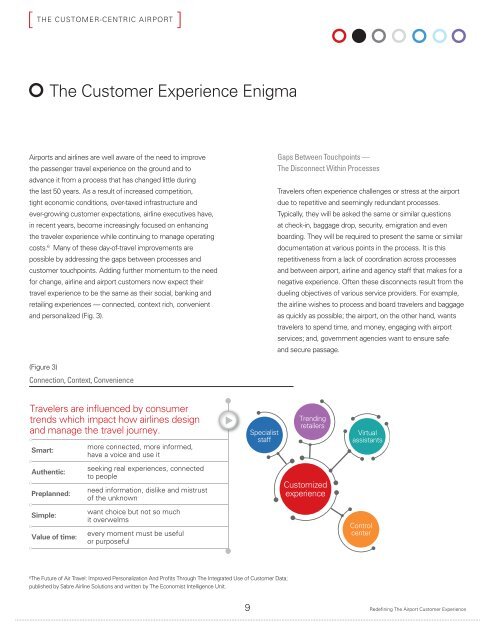WHITEPAPER THE CUSTOMER-CENTRIC AIRPORT
SabreSonic_The_Customer_Centric_Airport_Final
SabreSonic_The_Customer_Centric_Airport_Final
You also want an ePaper? Increase the reach of your titles
YUMPU automatically turns print PDFs into web optimized ePapers that Google loves.
<strong>THE</strong> <strong>CUSTOMER</strong>-<strong>CENTRIC</strong> <strong>AIRPORT</strong><br />
[<br />
[<br />
The Customer Experience Enigma<br />
Airports and airlines are well aware of the need to improve<br />
the passenger travel experience on the ground and to<br />
advance it from a process that has changed little during<br />
the last 50 years. As a result of increased competition,<br />
tight economic conditions, over-taxed infrastructure and<br />
ever-growing customer expectations, airline executives have,<br />
in recent years, become increasingly focused on enhancing<br />
the traveler experience while continuing to manage operating<br />
costs. 6 Many of these day-of-travel improvements are<br />
possible by addressing the gaps between processes and<br />
customer touchpoints. Adding further momentum to the need<br />
for change, airline and airport customers now expect their<br />
travel experience to be the same as their social, banking and<br />
retailing experiences — connected, context rich, convenient<br />
and personalized (Fig. 3).<br />
Gaps Between Touchpoints —<br />
The Disconnect Within Processes<br />
Travelers often experience challenges or stress at the airport<br />
due to repetitive and seemingly redundant processes.<br />
Typically, they will be asked the same or similar questions<br />
at check-in, baggage drop, security, emigration and even<br />
boarding. They will be required to present the same or similar<br />
documentation at various points in the process. It is this<br />
repetitiveness from a lack of coordination across processes<br />
and between airport, airline and agency staff that makes for a<br />
negative experience. Often these disconnects result from the<br />
dueling objectives of various service providers. For example,<br />
the airline wishes to process and board travelers and baggage<br />
as quickly as possible; the airport, on the other hand, wants<br />
travelers to spend time, and money, engaging with airport<br />
services; and, government agencies want to ensure safe<br />
and secure passage.<br />
(Figure 3)<br />
Connection, Context, Convenience<br />
Travelers are influenced by consumer<br />
trends which impact how airlines design<br />
and manage the travel journey.<br />
Smart:<br />
more connected, more informed,<br />
have a voice and use it<br />
Specialist<br />
staff<br />
Trending<br />
retailers<br />
Virtual<br />
assistants<br />
Authentic:<br />
Preplanned:<br />
seeking real experiences, connected<br />
to people<br />
need information, dislike and mistrust<br />
of the unknown<br />
Customized<br />
experience<br />
Simple:<br />
Value of time:<br />
want choice but not so much<br />
it overwelms<br />
every moment must be useful<br />
or purposeful<br />
Control<br />
center<br />
6<br />
The Future of Air Travel: Improved Personalization And Profits Through The Integrated Use of Customer Data;<br />
published by Sabre Airline Solutions and written by The Economist Intelligence Unit.<br />
9<br />
Redefining The Airport Customer Experience


